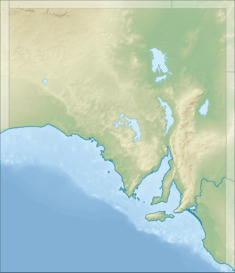Aroona Dam facts for kids
Quick facts for kids Aroona Dam |
|
|---|---|
|
Location of Aroona Dam in South Australia
|
|
| Official name | Aroona Dam |
| Country | Australia |
| Location | Leigh Creek, South Australia |
| Coordinates | 30°35′06″S 138°21′29″E / 30.58511139°S 138.35802359°E |
| Purpose | water supply |
| Status | Not known |
| Construction began | 1952 |
| Opening date | 1957 |
| Construction cost | A£1,000,000 |
| Owner(s) | Government of South Australia |
| Operator(s) | Government of South Australia |
| Dam and spillways | |
| Type of dam | Gravity |
| Height (thalweg) | 24 metres (80 ft) |
| Width (crest) | 236 metres (775 ft) |
| Dam volume | 44,400 cubic metres (58,100 cu yd) |
| Spillways | 1 |
| Reservoir | |
| Creates | Aroona Dam |
| Total capacity | 7,500 megalitres (1,650,000,000 imp gal) |
| Catchment area | 730 square kilometres (280 sq mi) |
Aroona Dam is a large reservoir (a man-made lake) in South Australia. It is located about 5 kilometers west of the town of Leigh Creek. The dam was built to store water for the local community and industries.
Contents
What is Aroona Dam?
Aroona Dam is a type of dam called a gravity dam. This means it uses its own weight to hold back the water. The dam wall is about 80 feet (24 meters) high. It stretches across 775 feet (236 meters). The lake behind the dam holds a huge amount of water. It extends for about 3.5 kilometers.
Where Did the Name Come From?
The name 'Aroona' comes from local geographic features. There is a mountain called Mount Aroona nearby. There was also a natural waterhole called Aroona Waterhole. This waterhole is now covered by the dam's waters. The local Adnyamathanha people called it Arrunha Awi.
Building the Dam
The Electricity Trust of South Australia built Aroona Dam. Construction started in 1952 and finished in 1957. The dam was built by blocking Arrunha Creek. This creek is also known as Aroona Creek or Scott Creek. Many of the workers were immigrants. They were hired for two-year contracts. At its busiest, about 160 men worked on the dam. Building work was often stopped during hot summer months. This was because it was too hot to pour concrete.
Why Was it Built?
The main reason Aroona Dam was built was to supply water. It provided water for the town of Leigh Creek. It also supplied the Leigh Creek Coalfield. Before the dam, these areas relied on artesian water from a place called Sliding Creek.
Over time, the dam's role has changed. In 2004, it supplied water to Leigh Creek, Copley, and Lyndhurst. It also helped nearby farms. Later, in 2016, it was decided that the dam's water would no longer be used for the town's drinking supply. Instead, Leigh Creek now uses treated artesian water. This water is cleaned using a special reverse osmosis plant.
Aroona Sanctuary
In 1995, the dam and the land around it became a protected area. This area is called the Aroona Sanctuary. It covers about 43 square kilometers. It was created under the National Parks and Wildlife Act 1972. This means the area is protected to help preserve its natural environment and wildlife.
Fun Activities
After the Leigh Creek Coalfield closed in 2015, the government started looking into new uses for the area. In 2017, they began studying if people could fish at Aroona Dam. This could make it a fun spot for outdoor activities in the future.


